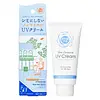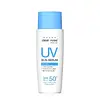What's inside
What's inside
 Key Ingredients
Key Ingredients

 Benefits
Benefits

 Concerns
Concerns

 Ingredients Side-by-side
Ingredients Side-by-side

Water
Skin ConditioningCyclopentasiloxane
EmollientEthylhexyl Palmitate
EmollientZinc Oxide
Cosmetic ColorantButylene Glycol
HumectantTitanium Dioxide
Cosmetic ColorantDimethicone
EmollientPEG-9 Polydimethylsiloxyethyl Dimethicone
EmulsifyingSodium Chloride
MaskingDisteardimonium Hectorite
StabilisingVitis Vinifera Fruit Extract
Skin ConditioningSalvia Officinalis Extract
AntimicrobialSodium Acetylated Hyaluronate
HumectantScutellaria Baicalensis Root Extract
AstringentMorus Alba Extract
AstringentAnthemis Nobilis Flower Extract
MaskingMalpighia Emarginata Fruit Extract
Skin ConditioningHydrolyzed Collagen
EmollientAloe Barbadensis Leaf Extract
EmollientDimethicone/Vinyl Dimethicone Crosspolymer
Skin ConditioningSorbitan Sesquiisostearate
EmulsifyingPhytosteryl/Isostearyl/Cetyl/Stearyl/Behenyl Dimer Dilinoleate
Skin ConditioningAluminum Hydroxide
EmollientStearic Acid
CleansingPEG-3 Dimethicone
Skin ConditioningDiglycerin
HumectantTrimethylsiloxysilicate
EmollientHydrogen Dimethicone
Phenoxyethanol
PreservativeGlycerin
HumectantWater, Cyclopentasiloxane, Ethylhexyl Palmitate, Zinc Oxide, Butylene Glycol, Titanium Dioxide, Dimethicone, PEG-9 Polydimethylsiloxyethyl Dimethicone, Sodium Chloride, Disteardimonium Hectorite, Vitis Vinifera Fruit Extract, Salvia Officinalis Extract, Sodium Acetylated Hyaluronate, Scutellaria Baicalensis Root Extract, Morus Alba Extract, Anthemis Nobilis Flower Extract, Malpighia Emarginata Fruit Extract, Hydrolyzed Collagen, Aloe Barbadensis Leaf Extract, Dimethicone/Vinyl Dimethicone Crosspolymer, Sorbitan Sesquiisostearate, Phytosteryl/Isostearyl/Cetyl/Stearyl/Behenyl Dimer Dilinoleate, Aluminum Hydroxide, Stearic Acid, PEG-3 Dimethicone, Diglycerin, Trimethylsiloxysilicate, Hydrogen Dimethicone, Phenoxyethanol, Glycerin
Water
Skin ConditioningCyclopentasiloxane
EmollientEthylhexyl Salicylate
UV AbsorberOctocrylene
UV AbsorberButyl Methoxydibenzoylmethane
UV AbsorberPropylene Glycol
HumectantCetyl Alcohol
EmollientC12-15 Alkyl Benzoate
AntimicrobialSilica
AbrasiveTitanium Dioxide
Cosmetic ColorantZinc Oxide
Cosmetic ColorantDicaprylyl Carbonate
EmollientVp/Hexadecene Copolymer
Glyceryl Stearate
EmollientPEG-100 Stearate
Phenoxyethanol
PreservativeEthylhexyl Triazone
UV AbsorberPolyacrylamide
Chlorphenesin
AntimicrobialNiacinamide
SmoothingC13-14 Isoparaffin
EmollientCetearyl Olivate
Cetearyl Alcohol
EmollientSorbitan Olivate
EmulsifyingAcacia Senegal Gum
MaskingPotassium Cetyl Phosphate
EmulsifyingTocopheryl Acetate
AntioxidantDisodium EDTA
Xanthan Gum
EmulsifyingCoco-Glucoside
CleansingEthylhexylglycerin
Skin ConditioningLaureth-7
EmulsifyingGlycerin
HumectantButylene Glycol
HumectantAllantoin
Skin ConditioningBisabolol
MaskingAloe Barbadensis Leaf Juice
Skin ConditioningSalix Nigra Bark Extract
Skin ProtectingHamamelis Virginiana Leaf Extract
Skin ConditioningCamellia Sinensis Leaf Extract
AntimicrobialBetaine
HumectantPalmaria Palmata Extract
Skin ProtectingTocopherol
AntioxidantCentella Asiatica Extract
CleansingMethicone
Emollient1,2-Hexanediol
Skin ConditioningTerminalia Ferdinandiana Fruit Extract
AntioxidantVitis Vinifera Seed Extract
AntimicrobialSodium Benzoate
MaskingPotassium Sorbate
PreservativeCalendula Officinalis Flower Extract
MaskingPolyglutamic Acid
Skin ConditioningMelaleuca Alternifolia Leaf Extract
PerfumingSaccharide Isomerate
HumectantGeranium Robertianum Extract
AstringentScutellaria Baicalensis Root Extract
AstringentHouttuynia Cordata Extract
Skin ConditioningCitrus Reticulata Peel Extract
Skin ConditioningCentaurea Cyanus Flower Extract
AstringentAspalathus Linearis Extract
Skin ConditioningEisenia Arborea Extract
Skin ConditioningPorphyra Yezoensis Extract
Skin ConditioningPhaseolus Radiatus Sprout Extract
HumectantMagnesium PCA
HumectantSodium Lactate
BufferingCopper Tripeptide-1
Skin ConditioningSerine
MaskingSucrose
HumectantUrea
BufferingGlycine
BufferingCalcium Chloride
AstringentPotassium Hydroxide
BufferingOrnithine
Skin ConditioningSea Salt
AbrasiveAlanine
MaskingMagnesium Chloride
Threonine
Histidine
HumectantAspartic Acid
MaskingValine
MaskingProline
Skin ConditioningDipotassium Phosphate
BufferingLysine
Skin ConditioningLeucine
Skin ConditioningTyrosine
MaskingIsoleucine
Skin ConditioningMagnesium Citrate
Skin ConditioningGlucosamine Hcl
Glutamic Acid
HumectantPhenylalanine
MaskingArginine
Masking1-Methylhydantoin-2-Imide
Skin ConditioningAsparagine
MaskingCitrulline
Skin ConditioningUric Acid
BufferingMethionine
Skin ConditioningTaurine
BufferingTryptophan
MaskingFormic Acid
PreservativeAmmonia
BufferingCysteine
AntioxidantGlutamine
Skin ConditioningWater, Cyclopentasiloxane, Ethylhexyl Salicylate, Octocrylene, Butyl Methoxydibenzoylmethane, Propylene Glycol, Cetyl Alcohol, C12-15 Alkyl Benzoate, Silica, Titanium Dioxide, Zinc Oxide, Dicaprylyl Carbonate, Vp/Hexadecene Copolymer, Glyceryl Stearate, PEG-100 Stearate, Phenoxyethanol, Ethylhexyl Triazone, Polyacrylamide, Chlorphenesin, Niacinamide, C13-14 Isoparaffin, Cetearyl Olivate, Cetearyl Alcohol, Sorbitan Olivate, Acacia Senegal Gum, Potassium Cetyl Phosphate, Tocopheryl Acetate, Disodium EDTA, Xanthan Gum, Coco-Glucoside, Ethylhexylglycerin, Laureth-7, Glycerin, Butylene Glycol, Allantoin, Bisabolol, Aloe Barbadensis Leaf Juice, Salix Nigra Bark Extract, Hamamelis Virginiana Leaf Extract, Camellia Sinensis Leaf Extract, Betaine, Palmaria Palmata Extract, Tocopherol, Centella Asiatica Extract, Methicone, 1,2-Hexanediol, Terminalia Ferdinandiana Fruit Extract, Vitis Vinifera Seed Extract, Sodium Benzoate, Potassium Sorbate, Calendula Officinalis Flower Extract, Polyglutamic Acid, Melaleuca Alternifolia Leaf Extract, Saccharide Isomerate, Geranium Robertianum Extract, Scutellaria Baicalensis Root Extract, Houttuynia Cordata Extract, Citrus Reticulata Peel Extract, Centaurea Cyanus Flower Extract, Aspalathus Linearis Extract, Eisenia Arborea Extract, Porphyra Yezoensis Extract, Phaseolus Radiatus Sprout Extract, Magnesium PCA, Sodium Lactate, Copper Tripeptide-1, Serine, Sucrose, Urea, Glycine, Calcium Chloride, Potassium Hydroxide, Ornithine, Sea Salt, Alanine, Magnesium Chloride, Threonine, Histidine, Aspartic Acid, Valine, Proline, Dipotassium Phosphate, Lysine, Leucine, Tyrosine, Isoleucine, Magnesium Citrate, Glucosamine Hcl, Glutamic Acid, Phenylalanine, Arginine, 1-Methylhydantoin-2-Imide, Asparagine, Citrulline, Uric Acid, Methionine, Taurine, Tryptophan, Formic Acid, Ammonia, Cysteine, Glutamine
Ingredients Explained
These ingredients are found in both products.
Ingredients higher up in an ingredient list are typically present in a larger amount.
Butylene Glycol (or BG) is used within cosmetic products for a few different reasons:
Overall, Butylene Glycol is a safe and well-rounded ingredient that works well with other ingredients.
Though this ingredient works well with most skin types, some people with sensitive skin may experience a reaction such as allergic rashes, closed comedones, or itchiness.
Learn more about Butylene GlycolCyclopentasiloxane, or D5, is a silicone used to improve texture of products and trap moisture.
D5 is considered lightweight and volatile. Volatile means it evaporates quickly after application. Once evaporated, D5 leaves a thin barrier that helps keep skin hydrated.
It is also an emollient. Emollients help soften the skin and prevent water loss. Silicones create a silky texture in products. D5 helps other ingredients become more spreadable.
Studies show D5 is safe to use in skincare products. We recommend speaking with a skincare professional if you have concerns.
Learn more about CyclopentasiloxaneGlycerin is already naturally found in your skin. It helps moisturize and protect your skin.
A study from 2016 found glycerin to be more effective as a humectant than AHAs and hyaluronic acid.
As a humectant, it helps the skin stay hydrated by pulling moisture to your skin. The low molecular weight of glycerin allows it to pull moisture into the deeper layers of your skin.
Hydrated skin improves your skin barrier; Your skin barrier helps protect against irritants and bacteria.
Glycerin has also been found to have antimicrobial and antiviral properties. Due to these properties, glycerin is often used in wound and burn treatments.
In cosmetics, glycerin is usually derived from plants such as soybean or palm. However, it can also be sourced from animals, such as tallow or animal fat.
This ingredient is organic, colorless, odorless, and non-toxic.
Glycerin is the name for this ingredient in American English. British English uses Glycerol/Glycerine.
Learn more about GlycerinPhenoxyethanol is a preservative that has germicide, antimicrobial, and aromatic properties. Studies show that phenoxyethanol can prevent microbial growth. By itself, it has a scent that is similar to that of a rose.
It's often used in formulations along with Caprylyl Glycol to preserve the shelf life of products.
Scutellaria Baicalensis Root Extract comes from the Baikal skullcap or Chinese skullcap plant. This plant is native to Northeast Asia and can be found in China, Mongolia, Korea, and Siberia.
In cosmetics, Scutellaria Baicalensis Root Extract provides antioxidant and anti-inflammatory benefits. This is due to the flavonoid composition of Scutellaria Baicalensis Root Extract.
In Chinese traditional folk medicine, Scutellaria Baicalensis Root Extract is used to help treat lung issues and hypertension.
Learn more about Scutellaria Baicalensis Root ExtractTitanium dioxide is a mineral UV filter widely used in sunscreens and cosmetics.
It is one of only two UV filters officially classified as “mineral” by regulatory agencies, the other being zinc oxide.
Titanium dioxide provides broad-spectrum protection mostly in the UVB and UVAII range, with some protection in the UVAI range.
While its UVA protection isn’t as strong as zinc oxide’s, the difference is minor.
A common myth is that mineral UV filters reflect UV light. However, modern research shows titanium dioxide absorbs UV radiation like chemical filters (~95% absorption & 5% reflection).
Thanks to its non-irritating nature, titanium dioxide is suitable for sensitive, acne-prone, or redness-prone skin. It is unlikely to cause "eye sting" like other sunscreen ingredients.
A major drawback of this ingredient is its white cast and thick texture. This is why mineral sunscreens often leave a white cast and are less cosmetically elegant than chemical/hybrid sunscreens.
To improve white cast and spreadability, micronized or nano-sized titanium dioxide is often used.
There are ongoing concerns surrounding nano-titanium oxide's impact on marine ecosystems.
There is no conclusive evidence that any form of titanium oxide (or any other sunscreen ingredients) will cause harm to marine ecosystems or coral reefs. The science is still developing but many consumers are keeping a close eye on this issue.
Please note, many destinations have reef-safety sunscreen rules. For instance, the U.S. Virgin Islands advises all visitors to use non-nano mineral sunscreens.
Nano mineral sunscreens once raised safety concerns about absorption into skin.
Extensive research has shown that they do not penetrate healthy or damaged skin; they remain safely on the surface and the top layer of dead skin (stratum corneum).
You'll likely find titanium dioxide bundled with alumina, silica, or dimethicone. These ingredients help make titanium dioxide highly photostable; this prevents it from interacting with other formula components under UV light.
Learn more about Titanium DioxideWater. It's the most common cosmetic ingredient of all. You'll usually see it at the top of ingredient lists, meaning that it makes up the largest part of the product.
So why is it so popular? Water most often acts as a solvent - this means that it helps dissolve other ingredients into the formulation.
You'll also recognize water as that liquid we all need to stay alive. If you see this, drink a glass of water. Stay hydrated!
Learn more about WaterZinc Oxide is a mineral broad-spectrum UV filter; it is the broadest UVA and UVB reflector approved by the FDA. It also has skin protectant and skin soothing properties.
Zinc oxide is one of the most effective broad-spectrum UV filters. It protects against UVB, UVAII, and UVAI. In comparison to its counterpart titanium dioxide, zinc oxide provides uniform and extended UVA protection.
Another great benefit? This ingredient is highly photostable so it won't degrade easily under sunlight.
A common myth is that mineral UV filters are widely believed to primarily reflect UV light.
However, modern research shows titanium dioxide absorbs UV radiation like chemical filters (~95% absorption & 5% reflection).
Zinc oxide has great skin soothing properties so you'll likely find this in sunscreens formulated for sensitive skin or babies/children. It is unlikely to cause "eye sting" like other sunscreen ingredients.
Regulatory agencies consider zinc oxide to be non-toxic and safe. It has also been shown to not penetrate the skin.
Unfortunately, this ingredient does leave a visible white cast. This is why mineral sunscreens are often less cosmetically elegant than chemical or hybrid ones.
In cosmetics, zinc oxide can be found in both non-nano and nano-sized forms. The nano version is used to reduce white cast and improve the texture of sunscreen formulas.
There are ongoing concerns surrounding nano-zinc oxide's impact on marine ecosystems and whether it can be absorbed into skin.
Regarding marine ecosystems and coral reefs, there is no conclusive evidence that any form of zinc oxide (or any other sunscreen ingredients) will cause harm. The science is still developing but many consumers are keeping a close eye on this issue.
Please note, many destinations have reef-safety sunscreen rules. For instance, the U.S. Virgin Islands advises all visitors to use non-nano mineral sunscreens.
There has also been some stir about whether micronized or nano zinc oxide has potential photoxicity and absorption through the skin/lungs.
An in-vitro (done in a test tube or petri dish) study demonstrated micronized zinc oxide to have potential phototoxicity. There's no need to fret; the EU Commission's Scientific Committee on Consumer Safety has stated, "The relevance of these findings needs to be clarified by appropriate investigations in vivo." Or in other words, further studies done on living organisms are needed to prove this.
Current research shows zinc oxide nanoparticles do not penetrate intact or sunburned skin. They either remain on the surface or in the outermost layer of dead skin (stratum corneum).
Zinc oxide is one of only two classified mineral UV filters with titanium dioxide being the other one.
Fun fact: Zinc has been used throughout history as an ingredient in paint and medicine. An Indian text from 500BC is believed to list zinc oxide as a salve for open wound. The Ancient Greek physician Dioscorides has also mentioned the use of zinc as an ointment in 1AD.
Learn more about Zinc Oxide